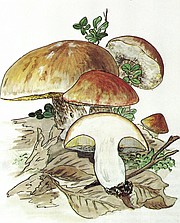Late September heralds mushroom season: Keys to success
I’m cheating on this column — it’s one (partly) I ran about four years ago but it says everything I want to say — with a few inserts- and serves as a lead-in for next week’s column of wild mushroom recipes! With fall nearly upon us, the following information is very timely.
For lovers of autumn, the blue of October’s skies and the gold and rich reds of the surrounding mountains in North Idaho are unexcelled anywhere. The bright yellow Larch needles pointing up the deep greens of our forests — the trembling quiver of turning Aspen leaves and brilliant blush of Rocky Mountain Maple make bright statements everywhere one turns. Red and Yellow Osier Dogwoods bare their brilliant stems to add to the gaiety — and in town the magnificent wine-red of countless Burning Bush carry the message through loud and clear — fall has come!
A walk in the woods is called for now, because the winter songbirds heed that message and swoop in flocks to the lower elevations to cheer us with their sweet songs, chirps and chuckles.
Friendly chickadees and nuthatches check out their last years’ holdings (fill the feeders!) and the heavenward trill of an unseen Hermit or Swainson’s thrush is the clarion call to get ready for winter!
And all that beauty is only enhanced by the experience of suddenly coming upon a great orange cluster of Chicken of the Woods growing from a dead stump among a plethora of other fungi and mushrooms or a flush of beautiful-but-deadly. We are blessed with an abundance of edible mushrooms, and learning where to find them is a delight. The area hosts “Icicle” (technically “toothed” ) corals from huge bushel-basket size to other smaller Coral mushroom varieties, plus the delectable Chanterelle, Boletes, Oyster, Shaggy Manes, and many more. And while most are generally considered edible, you have to be knowledgeable about these and other fungi. There are a few corals that are poisonous — and it’s worth it to educate yourself.
Start off by buying a good mushroom field guide. Check around and make the acquaintance of a few locals who might be willing to “show you around”. One can be self-taught, but a second person — or more — can point out things you should know.
Just to be on the safe side, consider “The Mycophagist’s Ten Commandments” - as presented in “Edible Wild Mushrooms of North America.”
- Never eat a mushroom unless it is positively identified as edible.
- Eat only fresh mushrooms that are free from infestations by insects or larvae.
- Thoroughly cook all mushrooms unless they are specifically known to be edible raw.
- Eat mushrooms only in moderate quantities.
- When trying a mushroom for the first time, eat only a small portion, and don’t try any other new kinds for 48 hours.
- Don’t pick mushrooms from contaminated habitats.
- Never assure that a wild mushroom you find overseas is the same edible species you know from North America.
- Be conservative about feeding wild mushrooms to children, the elderly and the infirm.
- When trying a mushroom for the first time, save a few intact, uncooked specimens in the refrigerator for 48 hours. If you have a reaction, take them with you when you seek medical attention.
- Examine every mushroom in every collection of gathered mushrooms to avoid inadvertent mIxing of different species.
Important things to keep in mind:
- When in doubt — throw it out! Be 100% sure of your identification.
- Attend forays when possible to enhance your knowledge — BUT don’t use information in any foray alone to identify mushrooms for the table.
- Educate yourself for well-rounded knowledge. Join a mycology club, spend time in the field with knowledgeable amateur and/or professional mycologists, and practice good collection and mushroom handling habits. Google North Idaho Mycological Association or contact the Spokane Mushroom Club at spokanemushroomclub.org.
Now, my extra special “tip of the day.” Take a drive to Ross Creek Cedars. A couple of hours’ drive through beautiful North Idaho and into Montana brings you to “Mushroom Heaven.” The ground around the easy trail through the great cedars displays more mushrooms than you can imagine even exist! Reds, purples, white, spotted, flat, cones, rounds, shelf, toothed, single and clustered — it’s amazing. Take your field guide and your camera - for this is NOT a foray, but a learning walk. The roaring water — (don’t miss the view of the falls at the overlook when coming or leaving) — the companionship of the great Cedars and the many native plants, birdlife and Peace will give you a new lease on life. You may even catch sight of a rare fisher, Pine marten, or a shy bobcat.
Last word: Watch the local supermarket shelves for fresh Chanterelles. That tells you it’s time to grab your book, bucket and go!
Valle Novak writes the Country Chef and Weekend Gardener columns for the Daily Bee. She can be reached at bcdailybee@bonnercountydailybee.com. or by phone at 208-265-4688 between the hours of 8 a.m. to 7 p.m.





